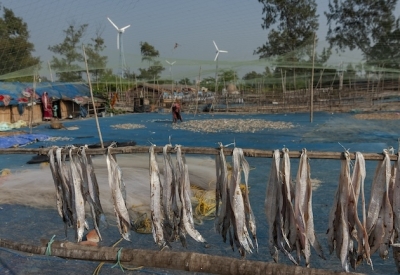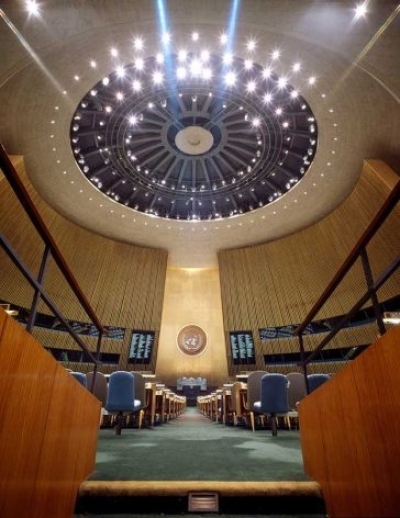The first humanitarian convoy into Gaza following two weeks of conflict crossed the border from Egypt on Saturday morning.
The 20 trucks carried food, water and medical supplies – items that are desperately needed, along with fuel — as stocks in Gaza dwindle, amid fears of increased deaths due to disease outbreaks and lack of healthcare.
While welcoming the development, agencies such as the UN Children’s Fund (UNICEF) have insisted that this cannot be the only convoy, and aid delivery must be continuous and sustained.
‘A drop in the ocean’
Jeremy Hopkins, UNICEF Representative in Egypt, said the agency’s contribution to the convoy – two trucks filled with 40,000 litres of bottled water – was but “a drop in the ocean”, given the immense needs in Gaza, including for a humanitarian ceasefire.
‘We also call on the parties to the conflict to avoid any targeting of health and education facilities, which allows us to deliver the aid safely to the health facilities and everywhere that they are needed,” he said.
Mr. Hopkins spoke to UN News several hours after the convoy passed through the Rafah crossing in southern Egypt, where hundreds more trucks are waiting should the border open up again.
He paid tribute to the dedicated UNICEF team on the ground who continue to serve under fire, and discussed the prospects for additional aid convoys.
This interview has been edited for clarity.
Jeremy Hopkins: Today, we were able to include two UNICEF trucks in the convoy with drinking water, 40,000 litres. It’s a drop in the ocean – literally, almost — and that will allow us to reach about 27,000 people with one day’s supply of drinking water. So, a very, very small amount went through today, which reinforces the urgent need to have a sustained humanitarian corridor that is open for supplies. And of course, we hope that there will be additional border posts opening so that the necessary supplies can get in.
UN News: Do you have any information about the next delivery and what that depends on? Do you also have additional emergency supplies in place once the next delivery is granted the green light?
Jeremy Hopkins: So, we have quite a good pipeline of water and water systems equipment, medicine and health systems equipment, and a number of other specialized items for child protection and childcare. We have, I think, 12 trucks loaded on stand-by at the border that can be crossed over in a matter of hours the next time it opens. And we have a pipeline sort of coming in by plane and by truck from Cairo and from international destinations with more medical supplies, more water, water systems supplies. Because we know that the priorities in Gaza right now are water, food, medicine and fuel, and so we are prioritizing our pipeline accordingly. We have one million bottles of drinking water in the pipeline ready, just for example, so we have big quantities of the necessary materials. We just need the corridor to be open on a sustained, continuous basis.
UN News: Is there any information about the next delivery?
Jeremy Hopkins: We know that the authorities and the different parties are continuing to discuss how to manage this border in a more sustainable way, and we have every hope that they will do so. I think the details will become clearer as they become clear.
UN News: We now have 20 trucks inside Gaza. What are the arrangements and preparations inside the Gaza Strip to deliver the lifesaving supplies?
Jeremy Hopkins: I want to first recognize that we have a very dedicated team of UNICEF State of Palestine staff in Gaza who have been working day and night under terrible, terrible conditions to deliver assistance. So assistance has been ongoing since the beginning and, of course, prior to this particular terrible, terrible round of conflict. I know that our colleagues in Gaza have been repositioning the health centres with pre-positioned medical supplies, keeping some of the water systems running. I know we are down to five per cent of the normal capacity, but there are some water systems running. The only desalination plant that is still going is done so with UNICEF’s support. So, our colleagues – and I want to pay tribute to them – are doing a fantastic job in Gaza.
What we know about the evolving needs is there are one million people displaced. We know that at least 300,000 children are displaced. That means they have no home right now or they are not at home, and that means that the humanitarian needs are extremely urgent. For example, according to international standards, each person should have 15 litres of water to live in health and dignity — that’s drinking and washing and cooking and everything else. Right now, it’s down to little less than three litres of water per person in Gaza. We have these kind of needs and we know how to respond. We simply need the corridor to be opened so that we can respond.
UN News: You said that what entered today is ‘just a drop in the ocean’. Do you know exactly how long the supplies that arrived into Gaza today can cover the needs of people there?
Jeremy Hopkins: What went in today cannot cover the needs at all. It’s a very tiny, tiny proportion of what is needed. We need to have instead of 20 trucks a day at least 100, 200 trucks going in per day — that of course depends on what is on the trucks, but approximately speaking — with food, water, medicine and fuel. That is a necessary condition for us to be able to respond to the humanitarian lifesaving requirements and needs right now.
UN News: Since there is no ceasefire right now, what are the challenges to delivering and moving supplies across Gaza?
Jeremy Hopkins: It is going to be challenging. We need to deliver, and we have a humanitarian imperative which is driving us. At the same time, we do call for a cessation of hostilities immediately. Of course, that is the only way that we can actually deliver safely. But at the same time, we also call on the parties to the conflict to avoid any targeting of health and education facilities, which allows us to deliver the aid safely to the health facilities and everywhere that they are needed.
And we also remind the parties that health staff need to be protected in order to carry out their mandate.





